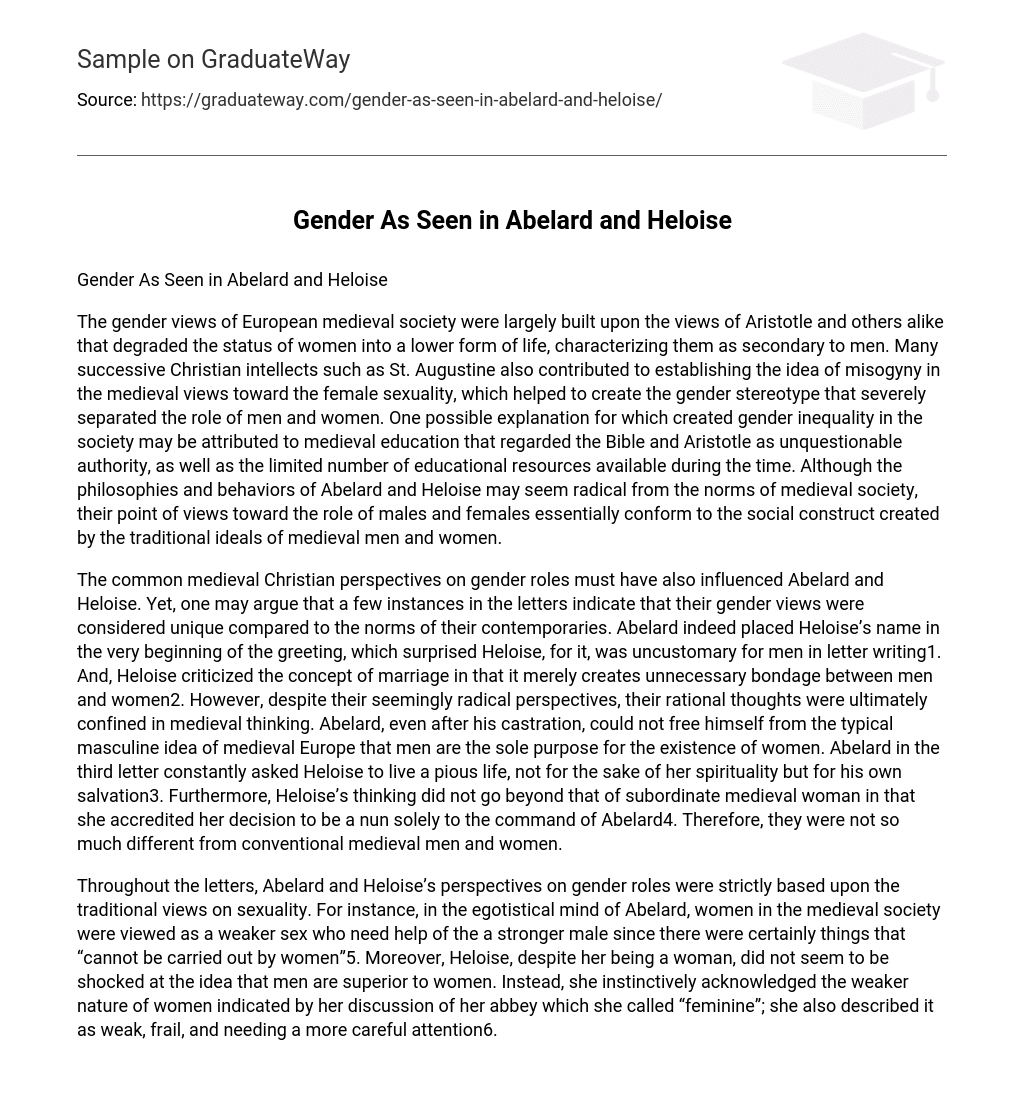The gender views of European medieval society were largely built upon the views of Aristotle and others alike that degraded the status of women into a lower form of life, characterizing them as secondary to men. Many successive Christian intellects such as St. Augustine also contributed to establishing the idea of misogyny in the medieval views toward the female sexuality, which helped to create the gender stereotype that severely separated the role of men and women. One possible explanation for which created gender inequality in the society may be attributed to medieval education that regarded the Bible and Aristotle as unquestionable authority, as well as the limited number of educational resources available during the time. Although the philosophies and behaviors of Abelard and Heloise may seem radical from the norms of medieval society, their point of views toward the role of males and females essentially conform to the social construct created by the traditional ideals of medieval men and women.
The common medieval Christian perspectives on gender roles must have also influenced Abelard and Heloise. Yet, one may argue that a few instances in the letters indicate that their gender views were considered unique compared to the norms of their contemporaries. Abelard indeed placed Heloise’s name in the very beginning of the greeting, which surprised Heloise, for it, was uncustomary for men in letter writing1. And, Heloise criticized the concept of marriage in that it merely creates unnecessary bondage between men and women2. However, despite their seemingly radical perspectives, their rational thoughts were ultimately confined in medieval thinking. Abelard, even after his castration, could not free himself from the typical masculine idea of medieval Europe that men are the sole purpose for the existence of women. Abelard in the third letter constantly asked Heloise to live a pious life, not for the sake of her spirituality but for his own salvation3. Furthermore, Heloise’s thinking did not go beyond that of subordinate medieval woman in that she accredited her decision to be a nun solely to the command of Abelard4. Therefore, they were not so much different from conventional medieval men and women.
Throughout the letters, Abelard and Heloise’s perspectives on gender roles were strictly based upon the traditional views on sexuality. For instance, in the egotistical mind of Abelard, women in the medieval society were viewed as a weaker sex who need help of the a stronger male since there were certainly things that “cannot be carried out by women”5. Moreover, Heloise, despite her being a woman, did not seem to be shocked at the idea that men are superior to women. Instead, she instinctively acknowledged the weaker nature of women indicated by her discussion of her abbey which she called “feminine”; she also described it as weak, frail, and needing a more careful attention6. Throughout the first four letters from Abelard and Heloise, they both held congruent views regarding masculinity and femininity, and this dichotomous way of looking at gender indeed did not deviate much from the conventional thinking of the medieval society.
Abelard and Heloise’s perspectives over the gender role in the society were also found in their discussions on the men-women relationship. As suggested by their agreement on the gender views, their reasoning over the relationship of lovers seemed to go no further from the notion that women are predestined to be an obstacle to men. Abelard bravely defended himself even in front of Fulbert, the uncle of the woman he mistreated, stating that it was Heloise, the woman, who brought the “noblest men to ruin”7. Also, Heloise fell into depression as she mourned over how the fate of women is only to “bring total ruin” on men8. These instances suggest that women were thought of as only harmful being in the society. Conversely, Abelard presented distinctive views toward women having a role of wife. He believed that men’s transgression could be pardoned by the prayers of his wife, suggesting that a woman, when married, could reconcile the relationship between God and her husband9. Although this may seemingly suggest that the status of women is promoted briefly, the belief that women exist only to be a helper of men’s salvation is not so different from the prevalent idea of the medieval society that women are secondary to men.
In conclusion, there were a few instances that Abelard and Heloise had opposing viewpoints on medieval men and women; yet in many occasions found in the letters, they both showed consistent gender views that men are superior to women. This well conforms to the traditional medieval thinking built upon the Aristotelian view, which effectively support the argument that Abelard and Heloise, despite their seemingly radical thoughts, could not entirely escape from the medieval worldview. Nonetheless, their continual efforts to question and reason with authority have certainly been influential in breaking away from the ingrained constructed view of gender and bringing about change and equality to the world.





